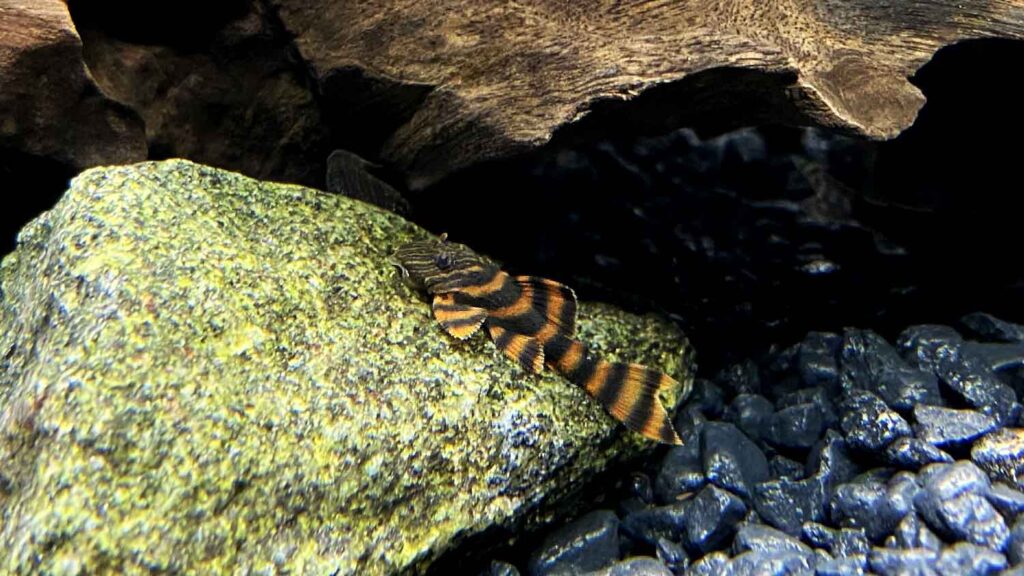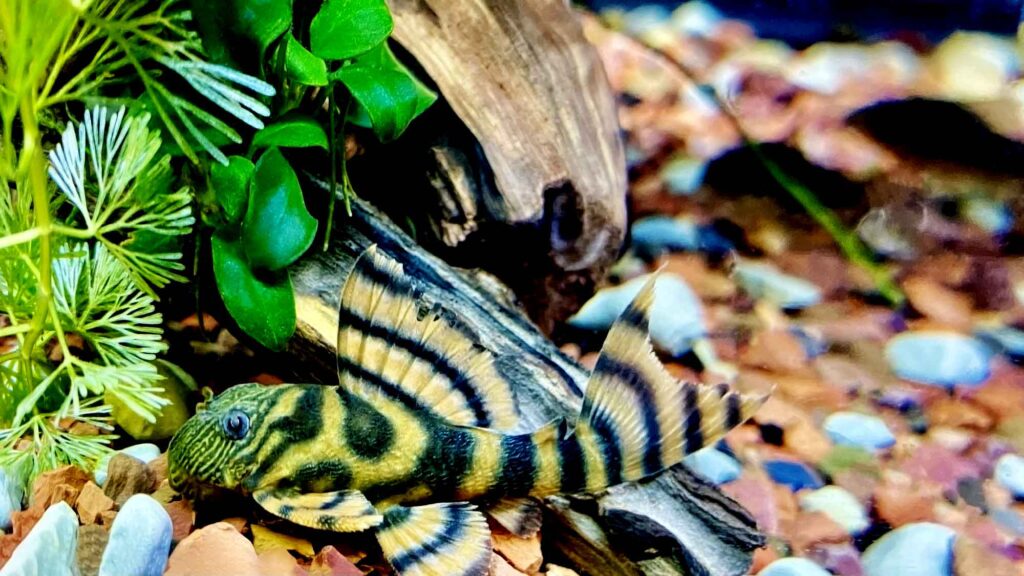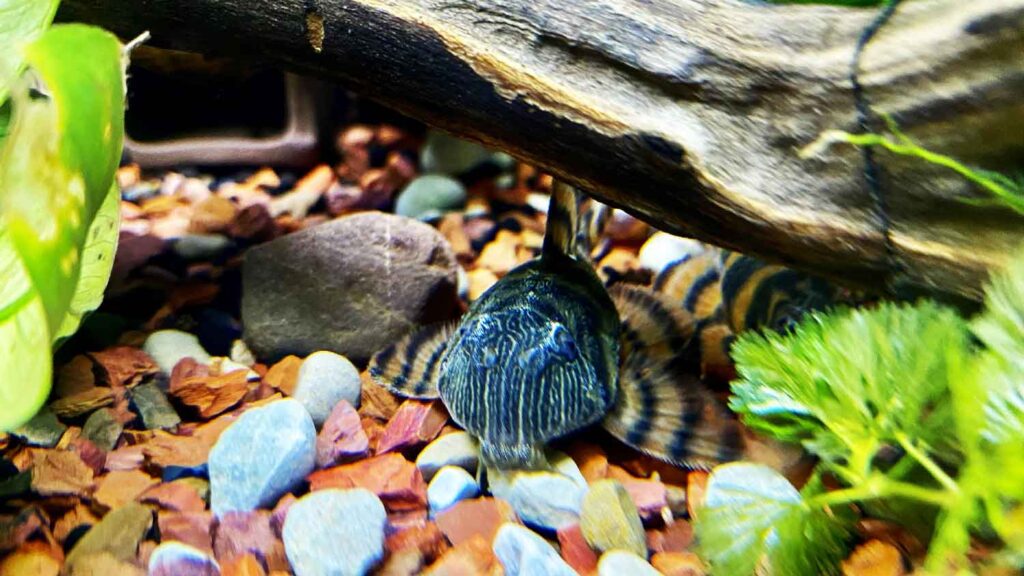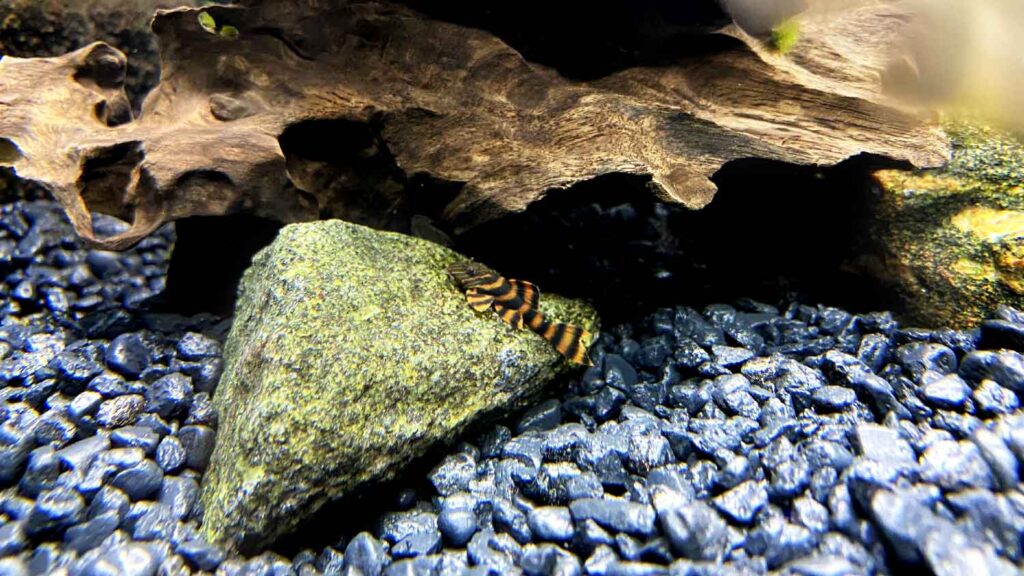L397 Pleco (Panaqolus sp. ) have recently become very popular among aquarium owners all over the world. They are easy to care for, which made them a good fit for most fish keepers of different skill levels. These hardy plecos will adapt to a wide range of aquarium parameters. However, they will thrive under specific tank setup and conditions.
In this guide, we’ll cover L397 Pleco care and everything else you might need to know about this fish. By the end of this article, you will have a good understanding of this fish.
Species Profile & Overview
L397 Pleco (Alenquer Pleco) is an armored catfish from the Loricariidae family native to the Alenquer region of Lower Amazon River in Para, Brazil. This is where this fish is being collected for the aquarium trade. In pet stores, you might see this fish under different names like L397 Pleco, Redstripe Pleco, or Alenquer Tiger Pleco. All these are different representations of the same fish.
This fish, like all its family members, has an armored back that is designed with beautiful uniformed black and red stripes. They have a half-cylinder body shape that is decorated with patterns to camouflage perfectly among woods and trees in the wild.
They live in well-oxygenated warm waterways that have slightly fast currents. They always stay at the streambed which is mostly sandy with big boulders and a lot of driftwoods where they can scavenge for food. Alenquer Pleco is currently in high demand compared to other types of plecos in the fish trade.
The Alenquer Pleco is not only beautiful but it also stays small and will not outgrow your tank. Which makes them a fantastic choice for smaller tanks.
Appearance

The L397 Pleco has a stunning red appearance that you can’t find in most other plecos. They might have a typical pleco shape but the patterns and color on their body make them stand out in the crowd.
Their cylinder body is covered with hard bone plates on the back and very soft skin under the belly. The eyes of the L397 Pleco are located on top of the head so they can monitor their surroundings at all times. Right under the eyes but a little pushed towards the front is their downward mouth.

The fins have a triangular shape that shares the same colors and patterns as the rest of the body. They have 8 fins in total that are used to swim and maneuver in the water.
Their red and black strips are uniformed and thick on the body but get very thin on the head. The color pattern is on the back and continues on their translucent fins as well. The belly area is usually light yellow with no visible patterns. However, some specimens seem to develop these patterns on their belly too but it’s not very common.
These bottom-dwellers have very bright orange when they are young but as they mature they will lose this vibrancy and the orange colors become slightly darker.
Adult Size
L397 Pleco size is about 3.5 – 4.5 inches in length. Which puts them in the small pleco category that can live in most aquarium sizes.
Compared to some of the other plecos, these fish are very fast growing. They will reach their max size in about one and a half years.
Lifespan
Alenquer Pleco lifespan is about 10 years. This is the average age and under the right conditions, they might live even longer.
However, this doesn’t mean your fish will reach this age. They reach this age when they are not under stress and get pristine care throughout their lifetime.

Behavior and Temperament
L397 Plecos have an incredibly peaceful temperament that makes them a great addition to any community tank. They are mostly active at night but will also come out during the day.
That being said, this doesn’t mean that these fish will not come out during the daytime at all. When they feel safe, they will go out during the day and will look for food or other business they might have in the tank.
They are also known to get a bit territorial with other bottom-dweller fish. This is particularly true with males, if you house more males in a tank they will fight over caves and hiding spots.
To avoid this aggressive behavior you will need to provide them with a large aquarium and lots of hiding spaces. Males will need to have a cave, so for each male species that you have, you will need to add a pleco cave to the tank.
L397 Pleco Care
L397 Pleco care isn’t very hard and many believe that these fish are one of the easier Pleco species to keep. We recommend this species for hobbyists of different levels.
Even still, providing them with the same conditions they get in the wild is the best way to keep them healthy. Clean water and a mix of different foods are ideal for this fish.
Here are some maintenance tips to keep your Alenquer Pleco in good health and happiness.
Tank Size
The minimum tank size for a single L397 Pleco is 20 gallons. They are one of the smaller plecos that can live in smaller tank sizes. That said, a large aquarium will make it easy to maintain constant parameters compared to smaller ones, So a bigger tank is even better.
However, when you keep more than one Alenquer Plecos, you will need to get a bigger aquarium. Like All bottom-dwellers fish, these guys need more bottom surface so the tank’s volume is not always the best way to calculate the number of plecos you can house.
The perfect aquarium for plecos is a tank that is wide and long. The height of the tank doesn’t matter that much. When you have a tank that is wide at the bottom you can have more plecos living in it even if it has less volume. To create even more surface in the tank, you can simply place a lot of driftwood, slates, or tiles. This will allow your fish to have more surfaces to explore.

Tank Setup
When it comes to plecos, the tank setup is very important. These fish are shy and nocturnal and will need specific items in the tank. L397 Pleco spends most of its time swimming at the bottom of the tank and on driftwoods. This means you will need to pay attention to the items you place in your aquarium.
You can use natural or artificial decorations to create hiding spots for your L397 Pleco so it feels safe. Natural decorations are the best way to go as they help you with balancing your tank’s parameters. Having a substantial number of driftwood and rocks will make your pleco feel safe.You should also add pleco caves in your tank so your pet pleco can hide in it during the day.
These fish are wood eaters so you will have to add many different types of wood in the tank so they can munch on. Wood is the most critical item you must have in your tank!
Plecos are almost always sitting on their soft belly and when they swim their bellies are very close to the bottom of the tank. Sharp substrates will eventually cause injuries to their abdomen area that might result in different types of infections. Sand is the most suitable substrate for plecos. You can also use planted tank substrate if you are planning to have freshwater plants.
Plants are necessary to create a healthy environment in the tank. Aquatic plants will clean your tank of pollutants while also providing plenty of hiding places for your fish. To improve the look and functionality of your aquarium, we strongly suggest adding plants.
Water Parameters
Water parameters are crucially important for L397 Pleco’s health and happiness. As you can see below they can live in a wide range of parameters; However, keeping your tank stable is the key to success with these fish. Try to match your tank to the parameters given below and more importantly maintain that. In the wild, these fish have well-oxygenated warm waters with low TDS. Below are the range you can keep Alenquer Plecos in:
Temperature: 75 – 86 Degrees Fahrenheit
PH: 6.5 – 7.5
TDS: 60 – 120 PPM
Investing in a reliable TDS (Total Dissolved Solids) meter is highly recommended. Every time your tank’s TDS crosses the ideal range you will need to perform a water change. TDS meter as well as a good test kit will help you create the perfect environment for your pet pleco.

Lighting
With the right tank setup, L397 Pleco does not have specific lighting needs and can adapt to any lighting conditions in the aquarium. So it’s best to choose your light according to the types of plants you are keeping in your aquarium.
Filter System
Like most plecos, L397 Pleco produces a large amount of waste. As a result, a powerful filter will be necessary to ensure that the water in your tank is always clean. Because Alenquer Plecos are very susceptible to ammonia surges, you must utilize the most powerful filtering equipment available. Large filters can remove waste while preventing ammonia levels from rising.
Common Diseases and Prevention
L397 Pleco is one of the hardy fish in the aquarium hobby, however, it lives in a tiny ecosystem called a fish tank. In a small space like an aquarium, diseases will easily and rapidly transfer between the living creatures. While there are no known species-specific diseases for L397 Pleco , these fish are at risk of most known aquarium diseases.
Prevention is the best cure! Most diseases and infections are directly caused by low water quality and a bad diet. Remind yourself to clean your tank regularly. Check the water parameters regularly to avoid parameter spikes in the tank. When it comes to L397 Pleco , changing water regularly is highly recommended. This will reduce the chances of diseases spreading in your tank and your fish will live happy and healthy. You should also never add new fish to your tank without properly quarantining them.
Diet and Feeding Requirements
Feeding this pleco is super easy as they will eat all types of different foods. L397 Pleco are omnivores which means they will eat both plant-based and high-protein meaty foods. This makes them one of the easiest plecos to feed. They should receive a balanced diet of vegetarian and nonvegetarian foods. They might also eat algae growing in the tank, however, this doesn’t mean Alenquer Plecos are good algae-eating pleco.
Wood is a stable part of their diet so you will have to have different types of driftwoods in your aquarium. These wood eating fish will need wood to survive in an aquarium.
They thrive on a plant-based diet, however they love to eat meaty and high protein foods as well. For protein, frozen or live foods like bloodworms, tubifex, daphnia, brine shrimp, and other small creatures make great choices. The good news is that you can find all of them in your local pet store and online.
Many high-quality dry foods are also available in pet stores and online that will provide your Alenquer Pleco with all the nutrition it needs. Dry foods are the ideal diet to feed your pleco daily as they are more affordable and widely available.
However, not all commercially made foods are made equal! To provide your fish with all the nutrition it needs, you must buy a few different types of foods to mix an ideal diet for your L397 Pleco. Plant based pellets or fish flakes mixed with a low amount of high-protein foods are an ideal combination to feed.
The L397 Pleco has a diverse diet in its natural habitat and will need a similar diet in captivity as well. Commercial foods and fresh vegetables like cucumber, zucchini, yams, brussels sprouts should be the primary diet they receive and live foods can be a snack they get one or two times a week.
Most fish foods sold in stores only have a few of the ingredients plecos eat in the wild. So you will need to feed them a few different types of sinking foods so they get a balanced diet. Feeding should be done at night and only feed as much as they eat overnight.

Breeding L397 Pleco
Breeding L397 Pleco is easy and can be done at home aquariums. To breed these fish you will need to create the right conditions in the aquarium and leave the rest to your fish.
In order to breed these fish, you will need your Alenquer Pleco to be mature and at least 2-3 years old. Once you confirm you have at least one male and one female in your breeding group, you can start to condition your fish for breeding.
If you have more males in your tank, then make sure that each male has a cave available in the tank for them. The rule of thumb is to add at least one cave per each male if not more.
Alenquer Pleco are cave breeders which means they need caves to breed. The cave should be slightly bigger than the male’s body; but, small enough that he can trap the female inside.
For breeding purposes, the male looks around for a suitable cave to trap the female in. When the male finds a suitable cave, he will clean it out and wait for the female to arrive. The male will then trap the female and will not let her leave the cave until she lays eggs.
L397 Plecos will lay about 30 – 50 eggs each time they breed. The majority of the eggs will hatch and the fry survival rate is high.
Once eggs are laid, the male will let the female leave the cave, and then it’s the male job to guard the eggs until they hatch. During this time, the male cleans the eggs and fans them so the eggs don’t go bad or get mold.
The eggs usually hatch within 7-10 days after being laid.
After hatching, the fry usually stay at the back of the cave and feed on their egg sacks for the next few days. The male will keep the fry in the cave for another 10 – 12 days until they are fully developed and ready to leave.
Once the fry are strong enough, they will escape the cave and will attach to driftwood or glass in the aquarium. The fry usually stays together in a cluster in a single spot until they grow to half an inch in length.
L397 Pleco Tank Mates
L397 Pleco is a great pleco for both beginner and advanced aquarists who want to add a beautiful fish to their tank. This is a peaceful fish that will not harm other tank mates and most other fish will not bother your Alenquer Pleco. There might be times when this fish acts aggressively but this is something that you can easily avoid.
Never overcrowd your aquarium as it might cause aggressive behaviors. More specifically, the L397 Pleco needs more bottom surface so fewer bottom dweller fish should be added. You will also need to avoid fish that are too large as they might try to eat your Alenquer Pleco. Adding aggressive fish is also prohibited as they might bully your pleco. Usually, most semi-aggressive fish from South America can make great tank mates. Here are a few tank mates you can consider:
- Angelfish
- Discus
- Tetras
- Guppies
- Mollies
- Other Plecos

Conclusion
Always make sure you have enough space in the tank for the amount of fish you keep. Only add fishes that require the same conditions and diet as your L397 Pleco (Alenquer Pleco). Doing this will ensure a healthy environment for your pleco and their tank mates. Now you know everything there is to know about this fish. If you can create a healthy environment for them then you should definitely bring one home